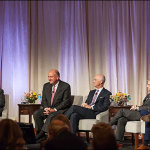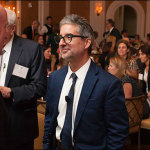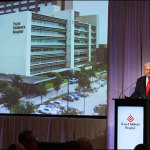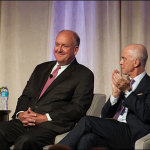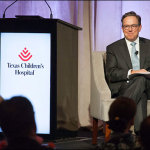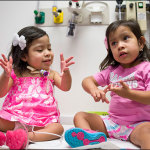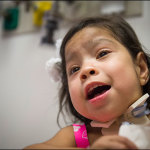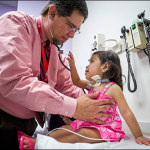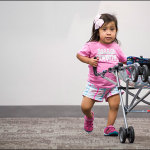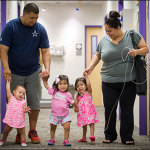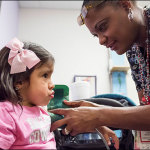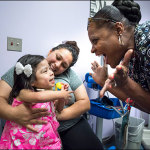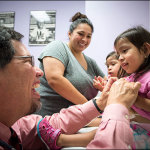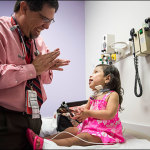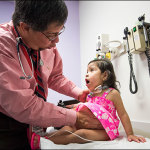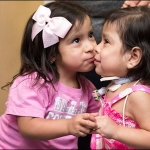September 27, 2016
 Community members attending the recent Forum Luncheon on September 21 got to meet the top surgical leaders at Texas Children’s Hospital and learn about the incredible ways they are making history in pediatric surgery and about their vision for the future of the hospital’s surgical enterprise.
Community members attending the recent Forum Luncheon on September 21 got to meet the top surgical leaders at Texas Children’s Hospital and learn about the incredible ways they are making history in pediatric surgery and about their vision for the future of the hospital’s surgical enterprise.
Following lunch and remarks from President and CEO Mark A. Wallace about the steady and rapid growth of Texas Children’s – including the Department of Surgery – Senior Vice President Mallory Caldwell moderated a panel discussion between: Surgeon-in-Chief Dr. Charles D. Fraser, Jr., Chief of Otolaryngology Dr. Ellis Arjmand, Chief of Plastic Surgery Dr. Larry Hollier and Chief of Neurosurgery Dr. Howard Weiner.
Caldwell focused on questions that highlighted why Texas Children’s Department of Surgery is bigger, better, faster and stronger than any in the nation and how the core mission of the department is to have the depth and breadth of expertise to deliver a surgical solution for every child in need of one.
Topics discussed include: the importance of outcomes measurement and how we have approached this work at Texas Children’s; the fact that Texas Children’s expertise is in treating common illnesses as well as complex, rare conditions; the strength and unique value in the department’s many multi-disciplinary teams; and our ability to recruit the best and brightest as we continue to grow and strengthen our team.
“When I came down here and learned about what is going on at Texas Children’s and the future trajectory of the organization, I knew I had to be here,” said Weiner, who recently joined Texas Children’s from New York University where he led a world-renowned neurosurgery program. “The leadership, the can-do attitude and the drive to grow as a world class institution providing high quality, attentive care to all children is very exciting.”
When Texas Children’s Hospital opened its doors in 1954, it did so with the one and only pediatric surgeon in the city of Houston. Today, Texas Children’s Hospital, now more than 90 surgeons strong, is one of the first two hospitals in the U.S. to be verified as a Level I Children’s Surgery Center by the American College of Surgeons.
Our surgeons have performed more than 350 heart transplants, making the heart transplant program one of the most experienced and active programs in the nation. We launched the first of its kind MRI-guided laser ablation surgery for epilepsy treatment, and we recently separated one of the most complicated cases of conjoined twins.
“Every time we have expanded it has been successful because we’ve done it for the right reasons,” Fraser said. “We are filling a specific need.”
The need for quality pediatric surgical care continues to grow and is a factor that convinced hospital leadership and its board of directors to add 19 floors to Pediatric Tower E near the Pavilion for Women. Much of the added space will house our expanded intensive care units and surgical facilities.
When Pediatric Tower E is complete, it will have 640,000 additional square feet of space, 130 beds for pediatric and cardiovascular intensive care, new operating rooms with the latest technology and a new and expanded Heart Center, including the outpatient clinic, cardiovascular operating rooms and catheterization labs.
Ultimately, Wallace said, the expansion will allow Texas Children’s Hospital to continue to provide the best possible family-centered care and best outcomes for the nation’s sickest children who come to us for help.
 Texas Children’s is the honored sponsor for every Tuesday’s “Houston Legends” series. We will showcase the legendary care Texas Children’s has provided since 1954, and focus on milestone moments in our unique history. Also, a complementary website offers a more detailed look at our past, our story and our breakthroughs.
Texas Children’s is the honored sponsor for every Tuesday’s “Houston Legends” series. We will showcase the legendary care Texas Children’s has provided since 1954, and focus on milestone moments in our unique history. Also, a complementary website offers a more detailed look at our past, our story and our breakthroughs.




